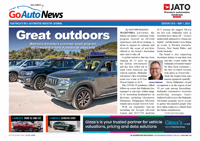Make / Model Search
Future models - Lexus - LBXLooking good for little Lexus LBXUnder evaluation for Australia, Lexus LBX is a CT200h successor based on Yaris Cross6 Jun 2023 CONTINUING the practice of leveraging Toyota bloodstock, Lexus has announced a Yaris Cross-based tiddler-size premium SUV model called the LBX.
Not yet locked in for this market – Lexus Australia says it has the LBX under evaluation – the newcomer sits beneath the UX range size-wise in the light SUV segment and could occupy showroom space vacated by the CT200h small hatchback that was dropped in 2021.
Indicative pricing is not yet available but the LBX, if it does make it to Australia, would be the only premium contender in the light SUV segment and join its Yaris Cross platform partner as the only other brand offering a hybrid drivetrain in this size category.
The Yaris Cross hybrid is priced from $29,840 for the base front-wheel-drive variant and from $32,840 for the least-expensive hybrid with all-wheel drive (both excluding on-road costs), so the LBX would be positioned well above that.
Lexus pitches the new LBX as a “reimagined compact luxury vehicle for youthful and urban buyers” with its three-letter designation breaking from brand convention somewhat and standing for Lexus Breakthrough X (crossover).
As is the case with all Lexus models, the newbie is said to boast premium levels of sophistication and refined quality; previously unseen in a car this size for the Australian market.
Built on the Toyota GA-B (TNGA-B) compact vehicle platform, the LBX version is modified and retuned to meet Lexus requirements.
Measuring 4190mm long, 1825mm wide and 1560mm tall, the LBX has a 2580mm wheelbase and will come fitted with wide 225mm tyres on 17 or 18-inch wheels, adding to the model’s bold design and wide stance that promise to give the vehicle presence on the road that belies its compactness.
Lexus says the LBX was formulated around the Tazuna concept of "human-centred" interior design that is evident with functions and controls intuitively placed for minimal driver eye movement and maximum attention on the road.
Its cabin said to create an illusion of space utilising “clever design elements that contribute to provide this effect”.
To this end, it has a simple, horizontal instrument panel to give the driver an open field of vision; a similar technique is used for the centre stack and other key interior elements.
Multi-layer absorption panels are used behind the dashboard and in the roof panel together with strategic use of high-dampening adhesives to reduce body vibrations and cut noise, aided by strategic location of engine mounts and use of a balancer shaft within the engine.
Exterior styling cues immediately identify the newcomer as a Lexus, with the latest interpretation of the brand’s trademark ‘spindle body’ at the front featuring a tapered bonnet and angled headlights that Lexus says “give the impression of forward motion”.
From the side, the minimal front and rear overhangs and low riding stance give the LBX a well-planted look.
Signature L-shaped rear lamps with a horizontal LED strip light are featured with Lexus lettering centred on the tailgate.
During uphill and downhill driving, the system detects variations in road incline and provides assistance by adjusting the acceleration and deceleration torque, minimising the need for frequent accelerator and brake inputs. Further driver assist tech includes braking vehicle posture control to suppress pitch and improve brake feel and stability. The car boasts a comprehensive suite of active and passive safety features and technology, including: proactive driving assist, pre-crash safety, adaptive cruise control, lane departure alert and lane tracing assist.  All future models Alfa Romeo Alfa Romeo Abarth Abarth Alpine Alpine Alpina Alpina Audi Audi Aston Martin Aston Martin BMW BMW Bentley Bentley Chery Chery Brabham Brabham Chrysler Chrysler Chevrolet Chevrolet Cupra Cupra Citroen Citroen DS DS Dodge Dodge Fiat Fiat Ferrari Ferrari Foton Foton Ford Ford Great Wall Great Wall FPV FPV Haval Haval GWM GWM Honda Honda Holden Holden Hummer Hummer HSV HSV Infiniti Infiniti Hyundai Hyundai Jaguar Jaguar Isuzu Isuzu Kia Kia Jeep Jeep Land Rover Land Rover Lamborghini Lamborghini Lexus Lexus LDV LDV Mahindra Mahindra Lotus Lotus Mazda Mazda Maserati Maserati Mercedes-AMG Mercedes-AMG McLaren McLaren MG MG Mercedes-Benz Mercedes-Benz Mitsubishi Mitsubishi Mini Mini Opel Opel Nissan Nissan Peugeot Peugeot Pagani Pagani Proton Proton Porsche Porsche Renault Renault Ram Ram Rover Rover Rolls-Royce Rolls-Royce Skoda Skoda Saab Saab SsangYong SsangYong Smart Smart Suzuki Suzuki Subaru Subaru Toyota Toyota Tesla Tesla Volvo VolvoMotor industry news |
Click to shareLexus modelsResearch Lexus All future models Alfa Romeo Alfa Romeo Abarth Abarth Alpine Alpine Alpina Alpina Audi Audi Aston Martin Aston Martin BMW BMW Bentley Bentley Chery Chery Brabham Brabham Chrysler Chrysler Chevrolet Chevrolet Cupra Cupra Citroen Citroen DS DS Dodge Dodge Fiat Fiat Ferrari Ferrari Foton Foton Ford Ford Great Wall Great Wall FPV FPV Haval Haval GWM GWM Honda Honda Holden Holden Hummer Hummer HSV HSV Infiniti Infiniti Hyundai Hyundai Jaguar Jaguar Isuzu Isuzu Kia Kia Jeep Jeep Land Rover Land Rover Lamborghini Lamborghini Lexus Lexus LDV LDV Mahindra Mahindra Lotus Lotus Mazda Mazda Maserati Maserati Mercedes-AMG Mercedes-AMG McLaren McLaren MG MG Mercedes-Benz Mercedes-Benz Mitsubishi Mitsubishi Mini Mini Opel Opel Nissan Nissan Peugeot Peugeot Pagani Pagani Proton Proton Porsche Porsche Renault Renault Ram Ram Rover Rover Rolls-Royce Rolls-Royce Skoda Skoda Saab Saab SsangYong SsangYong Smart Smart Suzuki Suzuki Subaru Subaru Toyota Toyota Tesla Tesla Volvo VolvoMotor industry news |









Facebook Twitter Instagram